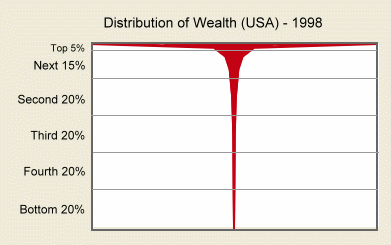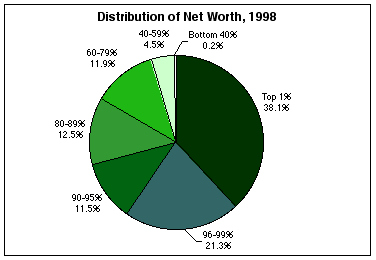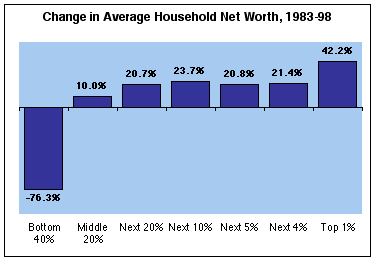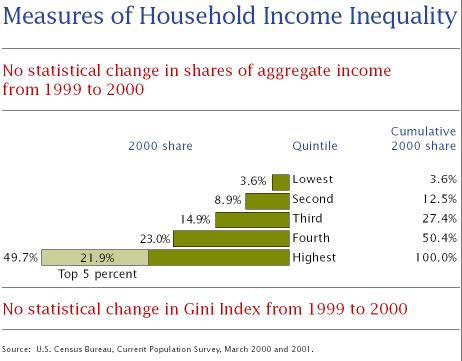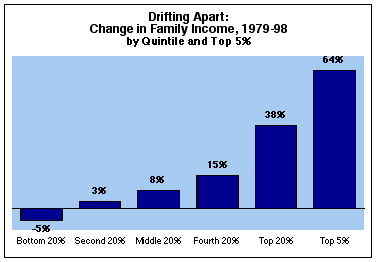
| Inequality in America
Contents Wealth Inequality | Income Inequality | The Rich and Super-Rich | Poverty 'Wealth' refers to total net worth or total assets, including financial assets (such as cash, stocks, etc.) and other assets (such as house). Wealth is different from 'income' which is the annual amount of money earned in a year. Most of the wealth calculations are based on 'households', and average household sizes are 3 people. Most of the facts are from: Edward N. Wolff, "Recent Trends in Wealth Ownership, 1983-1998," April 2000. Table 2. (Courtesy, United For a Fair Economy)
Share of national wealth by percentage of population. - Edward N. Wolff, "Recent Trends in Wealth Ownership, 1983-1998," April 2000 (Original graph by Devesh Kumar)
The top 1% of Americans own as much wealth as the bottom 95% percent. Source: Edward N. Wolff, "Recent Trends in Wealth Ownership, 1983-1998," April 2000. The total wealth owned by the top 1% of Americans is equivalent to 200 times the total combined wealth of the bottom 40%. (Or, the top 1% owns 200 times the wealth of the bottom 40% The total wealth of the top 60% of Americans is 500 times the total wealth of the bottom 40%. Bill Gates, America's richest individual, alone has more wealth than 40% of the U.S. population combined, or 120 million people. The top 1% of households own almost 40% of the
nation's wealth. The bottom 40% of households own one-fifth of 1% (or 0.2%) of the nation's wealth. The bottom 80% of Americans own only 15% of the nation's wealth.
The total wealth owned by the top 1% of Americans is equivalent to 200 times the total combined wealth of the bottom 40%. (Or, the top 1% owns 200 times the wealth of the bottom 40% The total wealth of the top 60% of Americans is 500 times the total wealth of the bottom 40%. The total wealth of the top 40% of Americans is 475 times the total wealth of the bottom 40%. The total wealth of the top 40% of Americans is 20 times the total wealth of the bottom 60%.
Source: Edward N. Wolff, "Recent Trends in Wealth Ownership, 1983-1998," April 2000. Table 2. (Courtesy, United For a Fair Economy) Percentage of nation's wealth owned by:
The top 1% of households own almost 40% of the
nation's wealth. The bottom 40% of households own one-fifth of 1% (or
0.2%) of the nation's wealth. The top 1% of Americans could live for an average of 555 years at basic living standards (defined as 125% of the national poverty line of $13,000 per household per year). Average household wealth for all Americans is $270,000. The average wealth of the top 1% of Americans is $10 million ($10,000,000). The average wealth of the bottom 40% of Americans $1,000.
In the fifteen years between 1983 and 1998, the bottom 40% of Americans saw their wealth drop 76%. (In other words, they lost three-quarters of their wealth in 15 years). In the same time period, the richest 1% saw their wealth increase by 42%. The richest 40%, excluding the richest 1%, saw their wealth increase roughly 20%.
'Income' means annual earnings or increase in wealth (for example, the increase in the value of stocks) over a one year's period. This is different from 'wealth', which is the total cumulative assets or net worth. Top Facts
The richest 1% of Americans earned as much income (after taxes) in 1999 as the bottom 38%. (In other words, the 2.7 million Americans with the highest incomes will have as much after-tax income as the 100 million Americans with the lowest incomes.) The Widening Income Gulf, Center for Budget Policy and Priorities The total income earned by the top 20% of Americans equalled the total income earned by the bottom 80%. (Or, the top 20% of Americans earned as much total income as the bottom 80%). (U.S. Census Bureau, 2000-01)
Trends in Income
In 1999, there were 268 billionaires. Bill Gates, America's richest individual, alone has more wealth than 40% of the U.S. population combined, or 120 million people. (Bill Gates net worth is approximately $50 billion. The total wealth of the bottom 40% of Americans is $40 billion.)
In 1999, there were 35 million people (or,
approximately 12% of the population) living below the poverty line
($13,000 income per year for a 3 person family) Poverty Rate in America, 1996: 13.7% Poverty rates in America by Race, 1996: Poverty rates in America by location of
residence: In 1998, 18.7 percent of American children lived in poverty Columbia University, (Inequality.org) Notes:
|
The top 1% of Americans own as much wealth as the bottom 95% percent.
The total wealth of the top 60% of Americans is 500 times the total wealth of the bottom 40%.
The bottom 40% of households own one-fifth of 1% (or 0.2%) of the nation's wealth.
Bill Gates alone has more wealth than 40% of the U.S. population combined, or 120 million people.
Sources & Resources
Wealth
Inequality Charts
United for a Fair Economy, Research Library
Recent Trends in
Wealth Ownership, 1983-1998
by Edward N. Wolff
Jerome
Levy Economics Institute
April 2000
